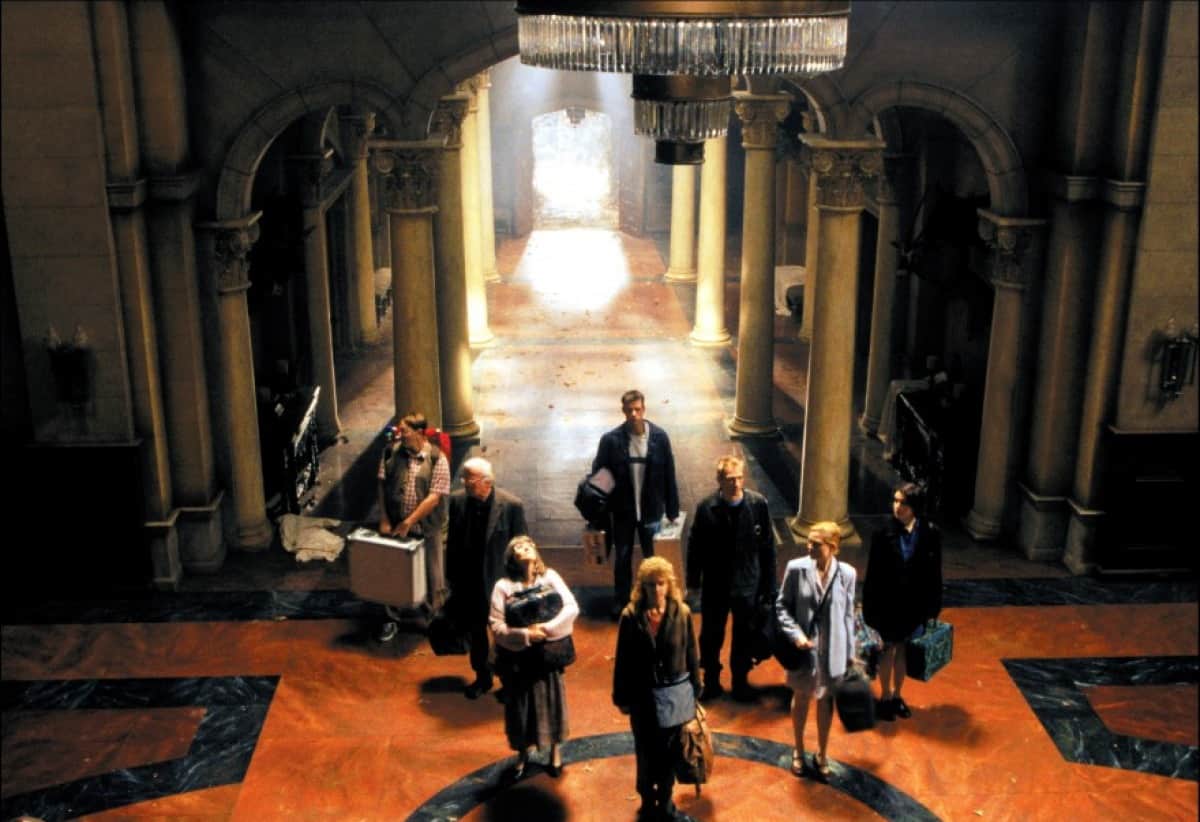
Inspired by the realities and legends surrounding the Winchester Mystery House, the 2002 mini-series Rose Red, written for the screen by Stephen King, centers around a desperate psychology professor and her team of psychics exploring the haunted Rose Red mansion. On the outside, Rose Red is a looming beast of a house that literally builds itself as it looks out over metropolitan Seattle; it’s a classic haunted mansion with gates and walls covered in dead vines and yards filled with mossy statues and clouds of fog. But within, it’s a fluctuating puzzle of dark, beautiful hallways and rooms where ghosts lead visitors to their doom.
Part of Rose Red’s charm comes from its characters. Matt Ross (American Psycho) is stunning as Emery, an anti-social, “momma’s boy” with the ability to see the dead, and Julian Sands is effortlessly charming as the mindreading Nick Hardaway. Nancy Travis has some wonderful moments as Joyce Reardon, a once revered college professor now attempting to exploit the spirit world for personal gain and a sense of purpose. Other more recognizable stars appear, such as Jimmi Simpson (It’s Always Sunny in Philadelphia), who plays ambitious college journalist Kevin Bollinger, a pleasant and then horrifying addition, and Emily Deschanel (Bones), who plays the psychometric Pam Asbury.
But the most interesting character is the mansion itself. “House’s are alive,” Ellen Rimbauer whispers as the camera tracks over the ghastly estate. It seems Rose Red has a ghost story for each of its literally countless rooms, and each ghost serves as a memory or emotion that helps control the mansion’s actions. Through scattered vignettes of spirits and deaths, the series gracefully reconstructs Rose Red’s extensive and gruesome history. Gilded Age construction workers murdering one another and dying in freak accidents. A financially ruined cowboy hanging himself in front of Rimbauer children (one of the best and most haunting scenes in the entire series). A young April Rimbauer disappearing from the kitchen one afternoon. Ultimately, the mansion is dejected and violent character, defined by a cycle of tragedy and evil where causality is uncertain.

Of course, haunted house stories are nothing new, and Rose Red certainly breaks no new ground, channeling similar plot points as House on Haunted Hill and Hell House. At times, the series relies too heavily on tacky CGI when the set pieces are haunting enough for a subtler approach. Moreover, it seems strange that Professor Reardon’s fascination with the supernatural is ruining her career. Prior to visiting Rose Red, Annie used her powers during pretty public outbursts, so you’d think people would maybe have an open mind at that point.
Nonetheless, the most intriguing aspect of Rose Red is its stark dissimilarity to Stanley Kubrick’s adaptation of The Shining, the most notable of haunted house stories in Stephen King’s extensive catalog. While the Overlook Hotel is a working business in the desolate mountains, Rose Red is an abandoned edifice in the middle of busy Seattle, and these settings interact with their characters in vastly different ways. The Overlook Hotel concocts a mind game in which ghosts (literal and figurative) and isolation pollute the already volatile Jack Torrance and turn him into the physical danger. The haunted hotel and frozen hedge maze then become a fixed obstacle through which Wendy and Danny must escape. But Rose Red is different. It’s a metropolitan Venus flytrap where the physical danger is the house itself, and the ever-changing floor plan and the ghosts that hide there swallow people alive.
The two works have their similarities as well, which is due in part to Stephen King’s emphasis on the power of children. Much like The Shining has Danny Torrance and his titular powers, Rose Red has Annie, a young autistic girl with an abstract form of telekinesis and the ability to read minds, and both characters have a tremendous influence over their respective stories. But even the similarities highlight the differences. For instance, the early twentieth century party of ghosts that Professor Reardon’s camera picks up is reminiscent of the one Jack Torrance confidently strolls through to get a drink. Yet the haunting impact of The Shining’s crowded ballroom scene is due to its contrast to the film’s overall sense of isolation, each character going at it alone in the hotel’s bright, cavernous rooms and vacant hallways. Jack then attempts to follow the same unaided, grisly path as Mr. Grady, a testament to the disastrous impact that an individual can have.
But Rose Red’s party of post-war phantoms highlights the series’ emphasis on the influence of crowds, be it the psychics’ collective energy that stirs the mansion awake or the ghosts’ control over the house’s appetite and structure. In essence, Rose Red puts a demonic twist on a well-known African proverb, and thus, a village has raises a devil child.


